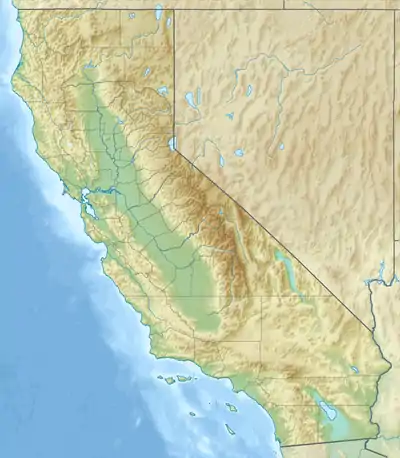Table Mountain (Tuolumne County, California)
Table Mountain is a mountainous landscape feature in Tuolumne County, California near the town of Jamestown. Table Mountain is an inverted valley, an elevated landform which follows the former contours of a river valley above level of the surrounding topography, rather than below it.[2] It was created by lava flows which filled an ancient river bed. The resulting igneous rock resisted erosion better than the materials around it, leaving behind a sinuous rock formation elevated above the surrounding landscape.
| Table Mountain | |
|---|---|
 Table Mountain | |
| Highest point | |
| Elevation | 1,919 ft (585 m) NAVD 88[1] |
| Coordinates | 37°58′59″N 120°26′04″W [1] |
| Geography | |
| Location | Tuolumne County, California, U.S. |
| Parent range | Sierra Nevada |
| Topo map | USGS Tuolumne |
Geology
Table Mountain is composed of Table Mountain Latite, which formed from potassium-rich lavas erupted from a center of volcanism near modern-day Sonora Pass around 10.4 million years ago. The lava flows followed the course of the ancestral Stanislaus River, filling the river valley. As the Sierra Nevada Mountains were uplifted, the softer sediments surrounding the flows were eroded away, leaving behind an inverted river valley. Although the formation stretches for miles and rises hundreds feet above the surrounding landscape, its width rarely exceeds a few hundred feet. Most outcrops on Table Mountain reveal flow-top breccias, while some outcrops show distinctive columnar jointing.[3]
The lava flow which covered the ancient river bed trapped auriferous, or gold-bearing, gravels beneath it, some of which have been accessed by mining operations dating back to the 1850s.
Ecology
A variety of flora and fauna are found on Table Mountain. In the spring, many wildflowers can be found atop the mountain including several species of lupine and the yellow mariposa lily, Calochortus luteus.[4] Vernal pools form on the flat top after heavy winter and spring rains, providing habitat for many uncommon plant and animal species. The harsh conditions found on top of Table Mountain generally prevent invasive plants from surviving, resulting in a landscape which is composed primarily of native plants.[5] White-throated swifts nest on the cliff faces that flank the mountain.[6]
References
- "Table Mountain". Geographic Names Information System. United States Geological Survey.
- Romans, Brian (October 2010). "Inverted Martian Topography". Wired Science.
- Gornya, C; Busbya, C; Pluhar, CJ; Hagana, J; Putirkab, K (2009). "An in-depth look at distal Sierra Nevada palaeochannel fill: drill cores through the Table Mountain Latite near Knights Ferry". International Geology Review. 51 (9–11): 824–842. Bibcode:2009IGRv...51..824G. doi:10.1080/00206810902944960.
- Hogan, C. Michael (2009). "Yellow Mariposa Lily". Globaltwitcher.com.
- Hayes, Garry (2011). "Geotripper". Geotripper.
- Nystrom, Siera (2017). "Wildflowers of the Sierra Nevada Foothills: Table Mountain Hike". Natural History Journal.